| 11 January |
• yesterday • tomorrow |
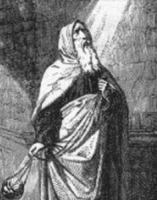
• Theodosius of Cappadocia
• Theodosius the Coenobriarch
• Theodosius the Great
• Theodosios, Theodossios
Born to a pious family, he began his studies at an early age, and became a lector while still a youth. The example of Abraham led him to leave home in order to properly follow God. He met Saint Simeon Stylites in Antioch; Simeon recognized him as a holy man and leader, and invited Theodosius onto his pillar for prayer, blessing, and advice. Travelled to Jerusalem where legend says worked with Saint Longinus the Centurian, who would have been nearly 500 years old at the time. Head of a church near Bethlehem.
Hermit in the desert of Judah, living in a cave. Word of his holiness began to attract disciples, and Theodosius built a monastery at Cathismus to house them. There were so many there had to be a section for Greeks, for Armenians, for Persions, etc., but they all happily worked and prayed together. Next to the monastery he built a hospital for the sick, a hospice for the aged, and a mental hospital. Friend of and co-worker with Saint Sabbas. Appointed visitor to all cenobitical communities of Palestine the patriarch of Jerusalem.
Opposed heresies, including Eutychianism and Monophysitism. Emperor Anastatius, a supporter of Eutychianism, sent Theodosius a large bribe, hoping to sway the influential monk to his thinking; Theodosius distributed the money to the poor, and continued to preach against heresy. Because of his orthodox views, Anastatius removed him from his position in 513, but he soon resumed his duties under emperor Justinian.
In poor health in his old age, he was stricken with a condition that made his skin dry as stone. He continued to work until his health gave out, and then he spent his time praying for his community. He died at age 105.
423 at Garissus, Cappadocia (modern Turkey)
• 529 at Cathismus of natural causes
• buried in the cave where he live as a hermit
• it became a noted site for pilgrimages and miracles
Cenobriach = head of people living a life in common
abbot hermit with iron bands on his neck and arms, chains and a money bag near him
file makers
https://catholicsaints.info/saint-theodosius-the-cenobiarch/
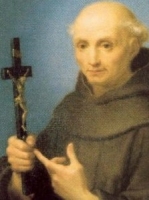
• Francesco Antonio Placidi
• Tommaso da Cori
• Thomas of Cori
Spent his youth as a shepherd. Studied philosophy and theology in Viterbo, Italy. Joined the Observant Franciscans in 1675. Parish priest, assigned to Civitella, Italy. Known for his simple life, his strict observance of the Franciscan way, and his gifts of healing. His preaching, confessions and spiritual retreats, incarnated the evangelical counsel of the total gift of self to God and his fellow men.
4 June 1655 in Cori, Latina, Italy as Francesco Antonio Placidi
11 January 1729 at Bellegra, Rome, Italy of natural causes
21 November 1999 by Pope John Paul II
"I'll take care of myself and my flock I'll take care of." (Ezekiel 34:11) Tommaso da Cori, a priest of the Order of Friars Minor, was the living image of the Good Shepherd. As a guide full of love, he has led the brothers entrusted to his care to the pastures of faith, always animated by the Franciscan ideal. In his monastery, he revealed his spirit of charity, showing available to all requirements even the most humble. He lived in the kingdom of love and service, according to the logic of Christ, as sung today’s Liturgy, "sacrificed himself, immaculate victim of peace on the altar of the cross, completing the mystery of human redemption." (Preface of Christ the King) Authentic disciple in the Poverello of Assisi, Saint Thomas of Cori was obedient to Christ, King of the Universe. He meditated and embodied in his life requirement evangelical poverty and the gift of self to God and neighbor. All his life appears as a sign of the Gospel, a testament to the love of the heavenly Father revealed in Christ and acting in the Holy Spirit, for the salvation of man. – Pope John Paul II in the canonization homily of Saint Tommaso
https://catholicsaints.info/saint-tommaso-da-cori/
Monk and hermit in the Gaza region. At age 60 he felt driven to travel to Alexandria, Egypt and work to save the area prostitutes. He had a unique method - he worked as a day labourer; with each day's wages he would hire a prostitute for the evening; but instead of the usual services, he requested that she spend the night without sin. To those who would listen he would teach and pray, and from each he extracted a promise to not describe the evening. Not surprisingly, this frequently led to controversy, gossip and opposition, but every investigation cleared him of any charge of impropriety. Some writers claim that he met and prayed with every prostitute in the city, and many of them were led to abandon the life and overcome the things that had driven them to it.
• he was struck in the head in 625 with a knife by a pimp who saw him leaving a brothel and wanted Vitalis to quit interfering with business in Alexandria, Egypt
• Vitalis managed to return to his hut and died alone soon after, apparently in prayer
Judge nothing before the time, until the Lord come, who both will bring to light the hidden things of darkness, and will make manifest the counsels of the heart. - Saint Vitalis
https://catholicsaints.info/saint-vitalis-of-gaza/
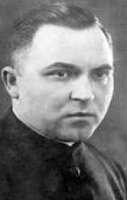
• Francesco Rogaczewski
• Francis Rogaczewski
• Frans Rogaczewski
12 June as one of the 108 Martyrs of World War II
Ordained in Gdansk, Poland in 1918. Pastor of Christ the King parish in Gdansk where be became a sought after confessor. Arrested on 1 September 1939 by Nazi invaders for the crime being a priest. Imprisoned and tortured for months before finally being executed. Martyr.
23 December 1892 in Lipinkach, Kujawsko-Pomorskie, Poland
shot on 11 January 1940 near Gdansk, Poland
13 June 1999 by Pope John Paul II
You know, I feel that I am going to die; tell my beloved believers in the church of Christ the King that I will gladly lay down my life for Christ and my homeland. – Blessed Franciszek from prison
https://catholicsaints.info/blessed-franciszek-rogaczewski/
22 November as one of the Martyrs of England, Scotland, and Wales
Married layman. Apprentice to several Catholic printers. Imprisoned and tortured for 18 months for "printing lewd (i.e., Catholic) pamphlets," possessing books upholding Catholicism, hiding vestments and other equipment in his home. His wife died while he was in jail. Eventually charged with printing and publishing the Treatise of Schisme, which allegedly incited violence by Catholics and which was said to have been written by a traitor and addressed to traitors; the jury debated 15 minutes before returning a guilty verdict. Martyr.
c.1549 at London, England
hanged, drawn, and quartered on 11 January 1584 at Tyburn, London, England
22 November 1987 by Pope John Paul II
https://catholicsaints.info/blessed-william-carter/
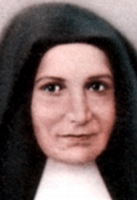
Studied at the Real Colegio de Educandras. Worked as a nurse in the Castelltort Hospital. Director the House of Charity and cared for orphans, young people and the elderly. Teacher. Established a hospital for the poor. Founded the Institute of Sisters of the Holy Family of Urgell on 29 June 1859. Today the Institute works in Spain, Andorra, Italy, Argentina, Paraguay, Uruguay, Chile, Colombia, Mexico, Peru and Equatorial Guinea; the Sisters work in schools, hospitals and nursing homes, missions, parishes and other apostolates.
18 December 1800 in Cervera, Lleida, Spain
11 January 1885 in Talarn, Lleida, Spain
8 October 2011 by Pope Benedict XVI
https://catholicsaints.info/blessed-anna-maria-janer-anglarill/
• Michael of Clopas
• Michel de Klops
• Michael van Klopsk
• Michael of Klops
• Mikhail of Klopsk
He was a monk who suddenly showed up at the Klopsk Abbey near Novgorod, Russia and who would no speak to anyone or answer any questions. The abbot gave him a cell and Michael sometimes slept there, sometimes in the fields, some times just stayed in church reading his Bible by candle light and praying all night. He was eventually found out as a member of the royal family, a cousin of Prince Constantin Dimietrievitch of Moscow, who had given up the worldly life to become a "fool for Christ".
• 11 January 1453 of natural causes
• relics hidden in the Klopsk Abbey
1547 (feast established)
https://catholicsaints.info/saint-michael-of-klopsk/
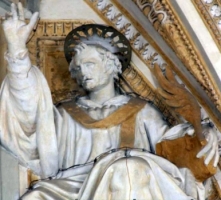
Hygin, Igino
Pope during a period of relative peace with no official persecutions of the early Church, but was forced to deal with with a series of heretic sects and preachers regularly popping up.
Athens, Greece
c.138
• 142 in Rome, Italy
• often listed as a martyr since so many of the early popes were, but there is no evidence of it for Hyginus
• buried on Vatican Hill near the tomb of Saint Peter the Apostle
https://catholicsaints.info/pope-saint-hyginus/
• Anastasius of Castel Sant'Elia
• Anastasius X
Benedictine monk at Suppentonia (modern Castel Sant'Elia), diocese of Nepi, Italy. Abbot at Suppentonia. Pope Saint Gregory the Great wrote that an angel appeared to summon Anastasius and his monks, all of whom died in rapid succession within the next eight days.
570 at Suppentonia, Italy of natural causes
Castel Saint'Elia, Italy
https://catholicsaints.info/saint-anastasius-of-suppentonia/
Salin, Salinius, Salve, Salvinus, Sauflieu, Saulve, Sauve, Sauvre
Hermit. Bishop of Amiens, France. Reported miracle worker.
c.625
• bishop with a casket of relics of Saint Firminus of Amiens
• preaching to his people from the pulpit
• finding the body of Saint Firminus of Amiens
• in the procession translating Saint Firminus of Amiens‘s relics
https://catholicsaints.info/saint-salvius-of-amiens/
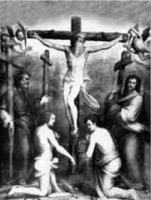
• Peter Apselamus
• Peter Balsamus
• Pietro Apselamo
Arrested for his faith in the persecutions of Maximinus. Tried by Severus, governor of Eleutheropolis; the transcript of their dialogue was famous in early Christian literature. Martyr.
Palestine
crucified in 311
https://catholicsaints.info/saint-peter-balsam/
Ethenea, Ethenia, Ethna, Ethnea
Daughter of King Leoghaire of Ireland; sister of Saint Fedelemia. She and her sister met Saint Patrick near the fountain of Clebach, received instruction in Christianity, were baptized, received their First Communion, and died in an ecstasy of love. An ancient church was built over her grave.
• c.433
• relics in the cathedral of Armagh, Ireland
https://catholicsaints.info/saint-eithne/
Fedelma, Fidelmia
Daughter of King Leoghaire of Ireland; sister of Saint Eithne. She and her sister met Saint Patrick near the fountain of Clebach, received instruction in Christianity, were baptized, received their First Communion, and died in an ecstasy of love. An ancient church was built over her grave.
• c.433
• relics in the cathedral of Armagh, Ireland
https://catholicsaints.info/saint-fedelemia/
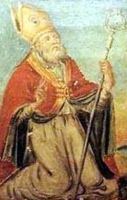
Leucio
Missionary from Alexandria, Egypt. First bishop of Brindisi, Italy.
Egyptian
180 of natural causes
Atessa, Italy
https://catholicsaints.info/saint-leucius-of-brindisi/
Typasius
Veteran soldier. During the persecutions of Diocletian, all soldiers were ordered to sacrifice to pagan idols; Tipasio refused. Martyr.
Tigava, Mauretania Caesariensis (modern El Kherba, Algeria)
beheaded on 11 January 304
https://catholicsaints.info/saint-tipasio-of-tigava/
18 June (translation of relics)
Fifth century nun in Pavia, Lombardy, Italy.
buried in the Basilica of San Vincenzo, Pavia, Italy
• lily
• three lilies
• with Bishop Epiphanius of Pavia
https://catholicsaints.info/saint-speciosa-of-pavia/
Sister of Saint Epiphanius of Pavia and Saint Liberata of Pavia. Nun at Pavia, Lombardy, Italy. Captured by King Odoacer of the Germanic Heruli, she was eventually ransomed back by Saint Epiphanius, and returned to Pavia.
c.500 of natural causes
https://catholicsaints.info/saint-honorata-of-pavia/
Fifth century nun in Pavia, Lombardy, Italy.
buried in the Basilica of San Vincenzo, Pavia, Italy
• lily
• three lilies
• with Bishop Epiphanius of Pavia
book sellers
https://catholicsaints.info/saint-luminosa-of-pavia/
Fifth century nun in Pavia, Lombardy, Italy.
buried in the Basilica of San Vincenzo, Pavia, Italy
• lily
• three lilies
• with Bishop Epiphanius of Pavia
https://catholicsaints.info/saint-liberata-of-pavia-11-january/
Alessandro
Bishop of Fermo, Italy. Martyred in the persecutions of Decius.
in Fermo, Italy
• c.250 in Fermo, Italy
• relics enshrined in the cathedral at Fermo, Italy
https://catholicsaints.info/saint-alexander-of-fermo/
Beandan, Brandan, Bran
Monk. Migrated from Ireland to Britain. Persecuted by Pelagian heretics, he sought refuge in a monastery in Gaul. It became his new home, and he eventually became abbot of the house.
5th century Irish
https://catholicsaints.info/saint-breandan/
Brother of Saint Tato and Saint Taso. Benedictine monk at Farfa, Sabina, Italy. The three brothers founded the monastery of San Vincenzo on the Voltorno river. First abbot of the house.
in Benevento, Italy
c.720 of natural causes
https://catholicsaints.info/saint-paldo/
Brother of Saint Paldo and Saint Tato. Benedictine monk at Farfa, Sabina, Italy. The three brothers founded the monastery of San Vincenzo on the Voltorno river. Second abbot of the house.
in Benevento, Italy
c.729 of natural causes
https://catholicsaints.info/saint-taso/
Brother of Saint Paldo and Saint Taso. Benedictine monk at Farfa, Sabina, Italy. The three brothers founded the monastery of San Vincenzo on the Voltorno river. Third abbot of the house.
in Benevento, Italy
c.739 of natural causes
https://catholicsaints.info/saint-tato/
One of a group of fifty Christian soldiers martyred as a group during the persecutions of Emperor Claudius II Gothicus.
martyred in 269 in Rome, Italy
https://catholicsaints.info/saint-theodosius-the-soldier/
One of a group of fifty Christian soldiers martyred as a group during the persecutions of Emperor Claudius II Gothicus.
martyred in 269 in Rome, Italy
https://catholicsaints.info/saint-lucius-the-soldier/
One of a group of fifty Christian soldiers martyred as a group during the persecutions of Emperor Claudius II Gothicus.
martyred in 269 in Rome, Italy
https://catholicsaints.info/saint-peter-the-soldier/
One of a group of fifty Christian soldiers martyred as a group during the persecutions of Emperor Claudius II Gothicus.
martyred in 269 in Rome, Italy
https://catholicsaints.info/saint-mark-the-soldier/
Monk. Founded a monastery in Cilicia (modern Çukurova, Turkey).
in Antioch (in modern Turkey)
412
https://catholicsaints.info/saint-theodosius-of-antioch/
Martyred for publicling proclaiming the faith.
Egyptian
martyred c.309 in Alexandria, Egypt
https://catholicsaints.info/saint-leucius-of-alexandria/
Martyred for publicling proclaiming the faith.
Egyptian
martyred c.309 in Alexandria, Egypt
https://catholicsaints.info/saint-severus-of-alexandria/
Martyred for publicly proclaiming the faith.
Egyptian
martyred c.309 in Alexandria, Egypt
https://catholicsaints.info/saint-peter-of-alexandria/
Sweeney
Monk. Abbot of Iona Abbey for about three years.
656 of natural causes
https://catholicsaints.info/saint-suibhne-of-iona/>
Benedictine monk, taking the cowl in France. Noted for strict observance of the Benedictine Rule, and for his gentle kindness.
Irish
https://catholicsaints.info/saint-boadin/
Martyred in Roman North Africa. Saint Augustine of Hippo preached about him.
https://catholicsaints.info/saint-salvius-of-north-africa/
Martyr.
burned alive at Eleutheropolis, Asia Minor, date unknown
https://catholicsaints.info/saint-peter-of-anea/
CatholicSaints.Info Portable Edition